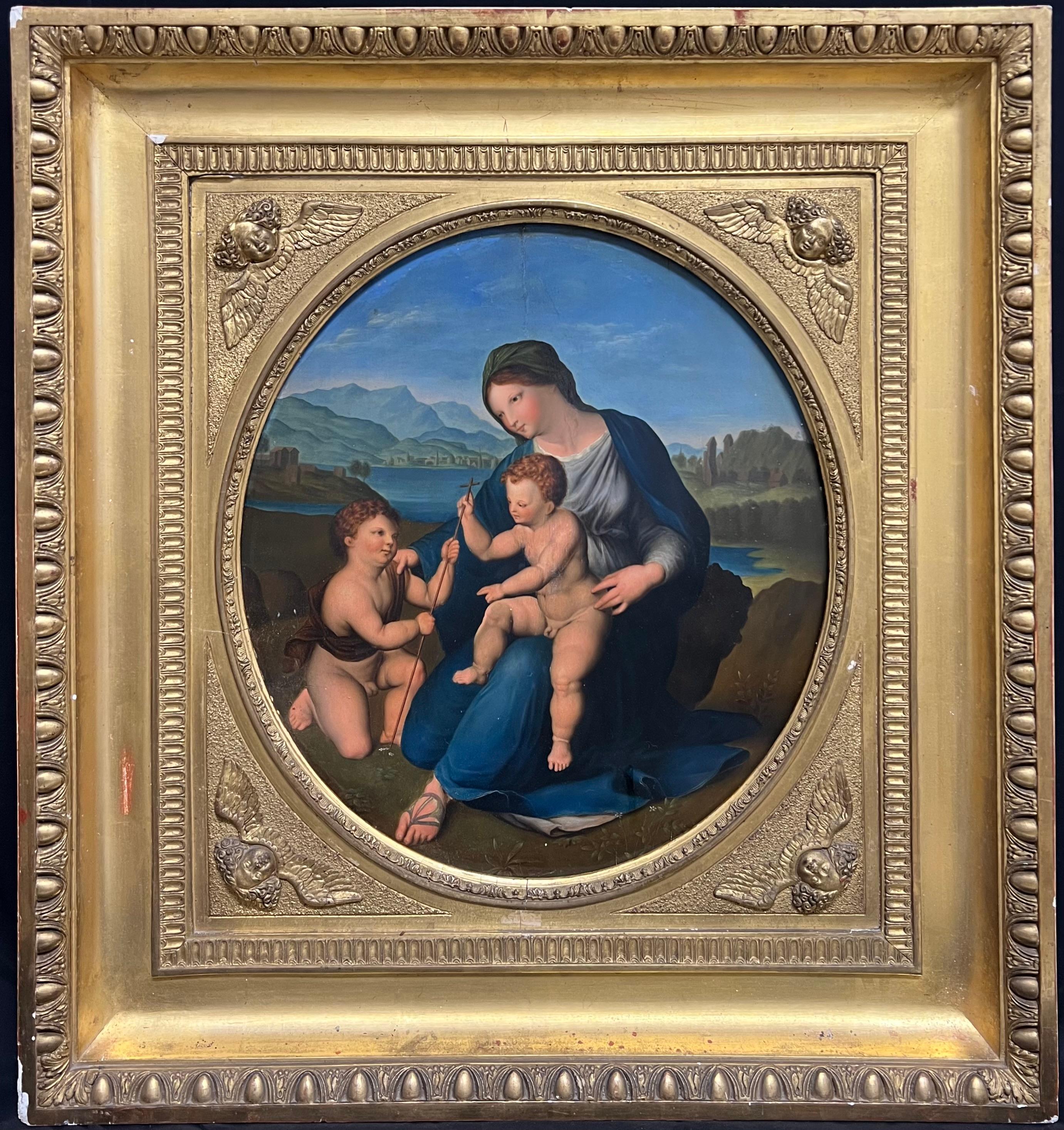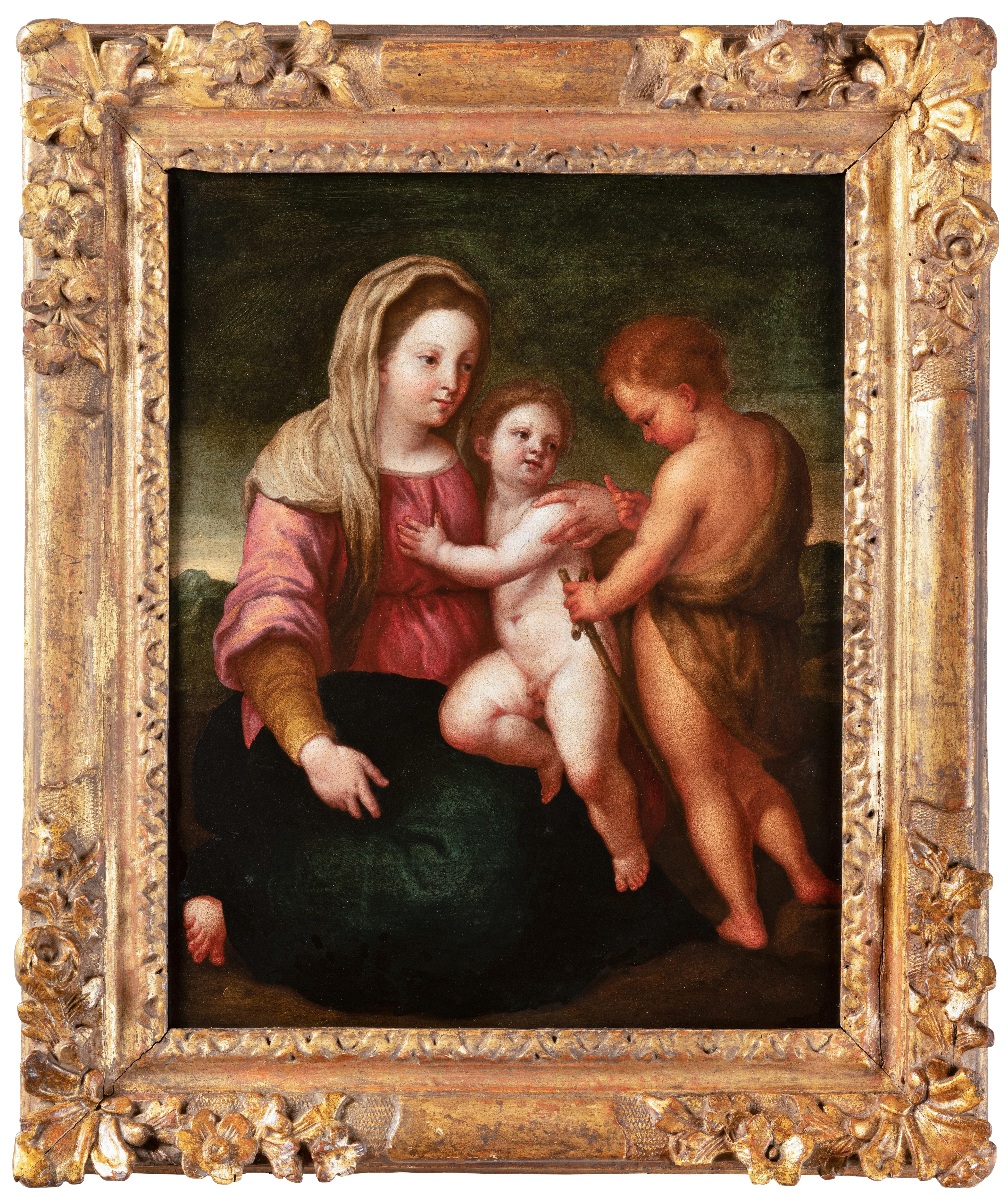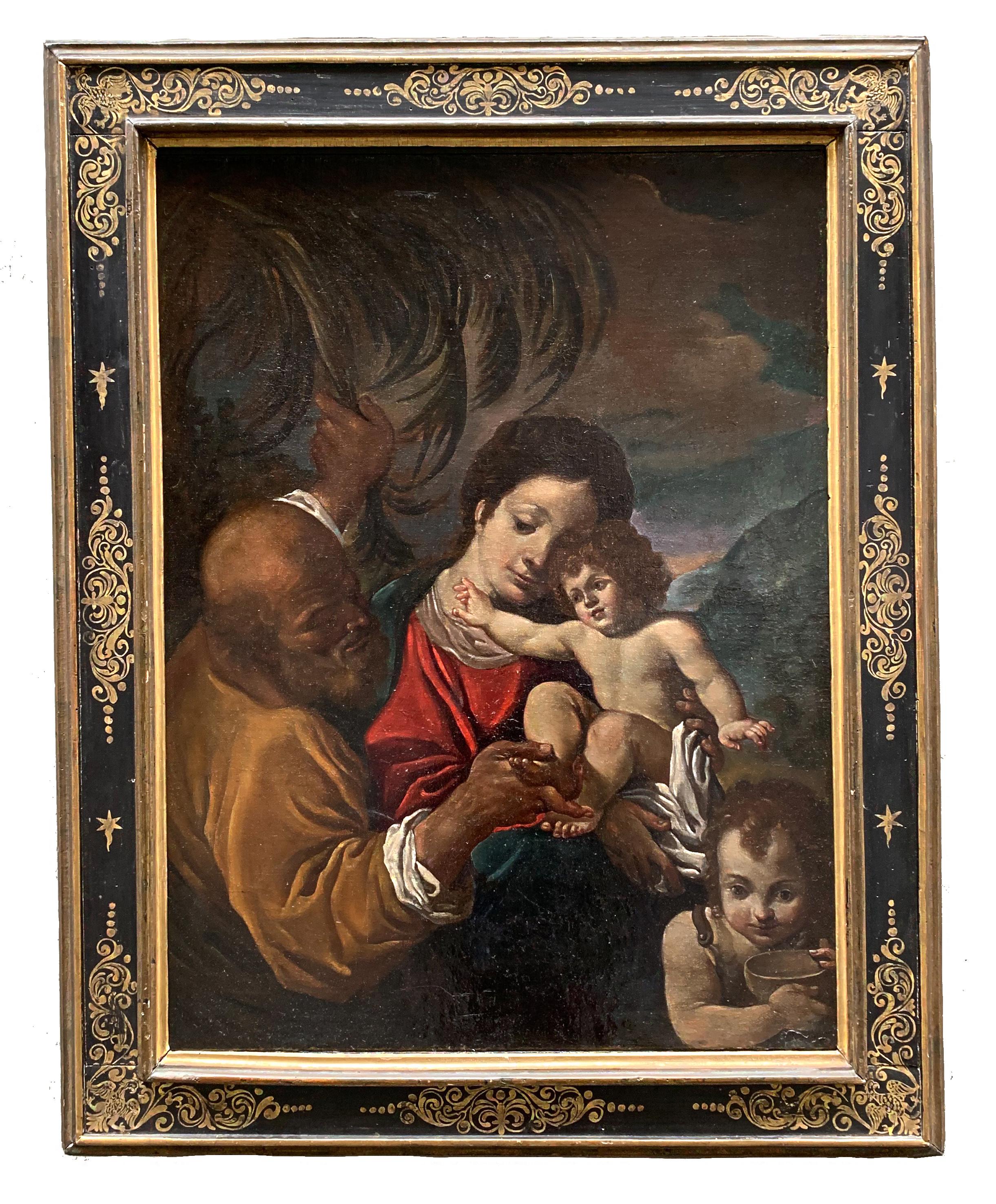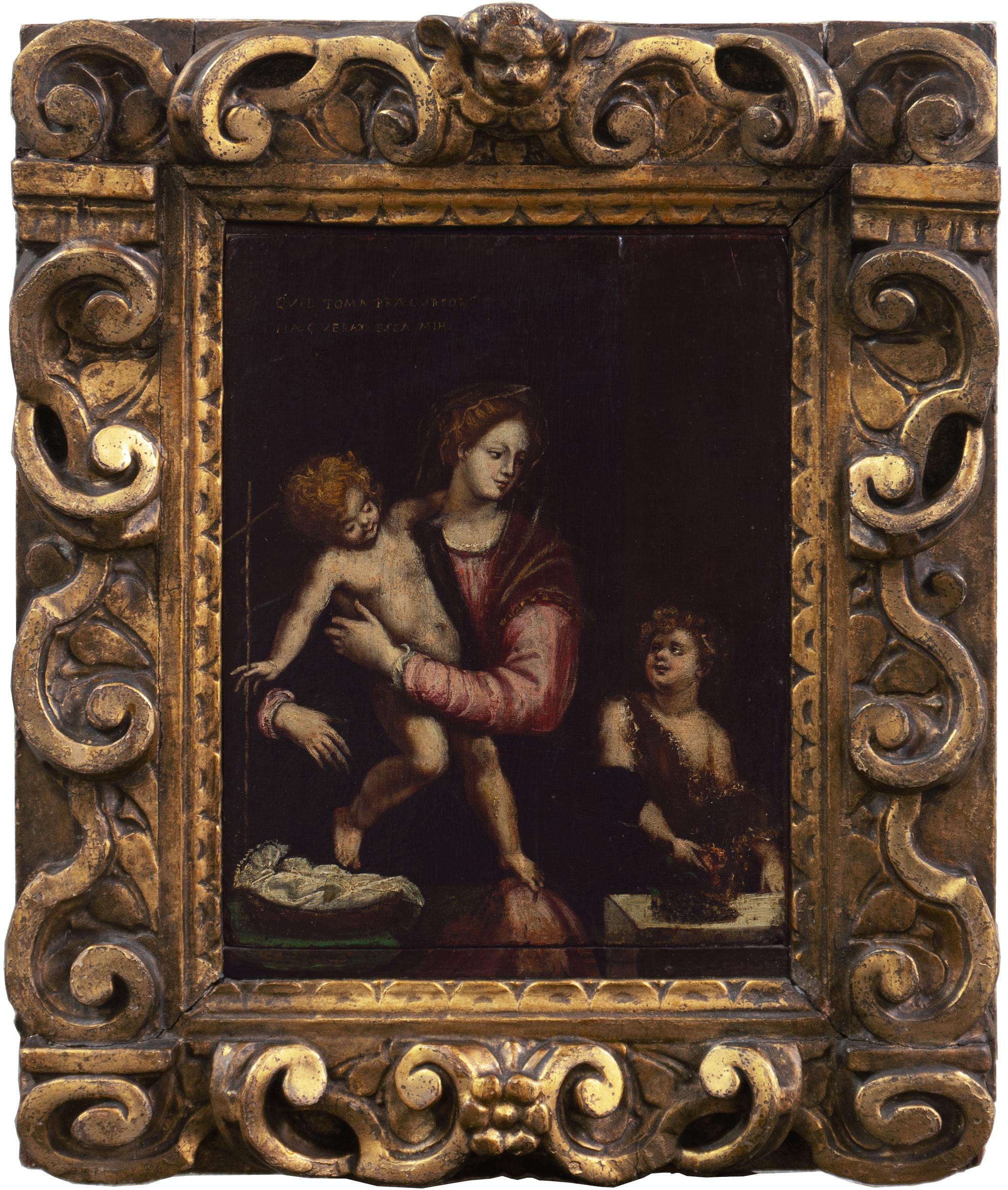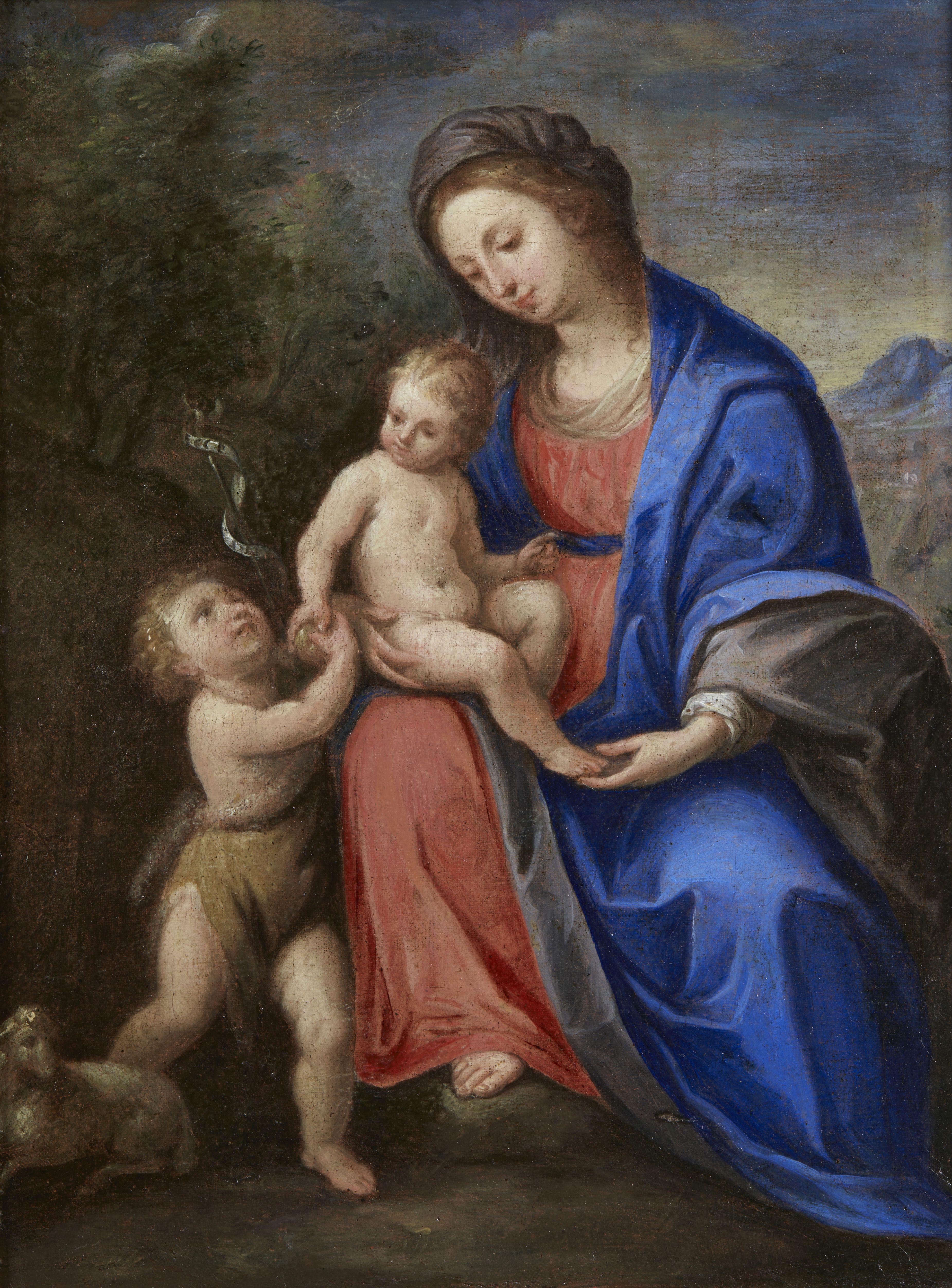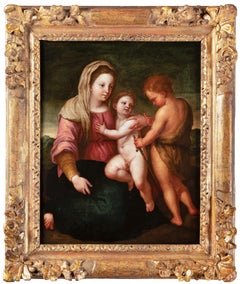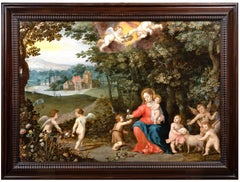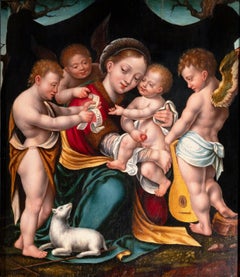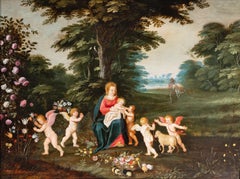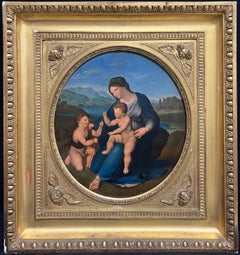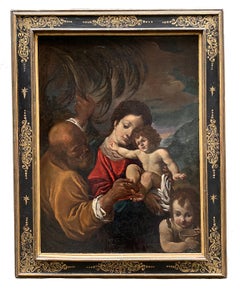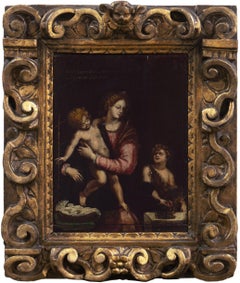Items Similar to 17th century Italian school, The Virgin and Child with Saint John the Baptist
Want more images or videos?
Request additional images or videos from the seller
1 of 14
Unknown17th century Italian school, The Virgin and Child with Saint John the Baptist
$25,253.19
£18,899.28
€21,300
CA$34,838.97
A$38,742.38
CHF 20,348.34
MX$473,664.49
NOK 253,559.79
SEK 239,038.40
DKK 162,146.18
About the Item
17th century Italian School
The Virgin and Child with Saint John the Baptist
Oil on canvas
Dimensions: h. 106 cm, l. 77 cm
Important 17th century Italian carved giltwood frame
Framed dimensions: h. 136 cm, l. 107 cm
Based on the composition by Franciabigio painted around 1517 (oil on panel, 106 x 81 cm) and exhibited in the Uffizi in Florence (inv. 1890, 1445)
The Virgin is seated in the heart of a bucolic landscape, she is represented from the front, with a slightly inclined head and her serene expression conveys a feeling of maternal tenderness. She holds in one of her arms the Child Jesus leaning on her breast and she extends the other hand to the little Saint John the Baptist who presents her with a banner. Mary is dressed in a pink dress and a blue mantle that envelops her in her lower part, the rounded and damp drapes in the antique style of the fabrics fall to the ground and reveal her bare feet. The naked Jesus seems to be hovering in the air, supported only by his mother's arm, his head turned towards the little Saint John the Baptist attracts the viewer's gaze while the feeling of the immediacy of the moment is accentuated by the gesture of Mary who leans in slight contrapposto towards the child.
Our work reminiscent of the Florentine Renaissance and the works of Raphael and Andrea del Sarto is based on a painting by a Florentine Franciabigio, whose real name was Francesco di Cristofano (1482-1525).
The original painting intended for the chapel of the Albizzi family in the church of Saint Peter the Major is mentioned for the first time in the 17th century in the inventory of Cardinal Carlo de Medici in Rome after his death in 1666. Our painting painted on a canvas woven with thick threads typical of the Roman school could thus have been executed at this period by an anonymous Roman artist.
Related works:
• A workshop or student replica, 16th century, oil on panel (100 x 80 cm), Saint Leonard Church, Artimino, Tuscany, Italy
• A workshop or student replica, 16th century, oil on panel, Uffizi Gallery, Florence
• A replica by Giuliano Bugiardini (Florence, 1475-1555), oil on canvas (102 x 77 cm), Valenciennes Museum of Fine Arts, inv. P.46.1.226
Bibliography: Franciabigio, Susan Mac Killop, University of California Press, 1974
- Dimensions:Height: 53.54 in (136 cm)Width: 42.13 in (107.02 cm)
- Medium:
- Movement & Style:
- Period:
- Condition:
- Gallery Location:PARIS, FR
- Reference Number:1stDibs: LU2433215389142
About the Seller
No Reviews Yet
Vetted Professional Seller
Every seller passes strict standards for authenticity and reliability
1stDibs seller since 2023
17 sales on 1stDibs
- ShippingRetrieving quote...Shipping from: PARIS, France
- Return Policy
Authenticity Guarantee
In the unlikely event there’s an issue with an item’s authenticity, contact us within 1 year for a full refund. DetailsMoney-Back Guarantee
If your item is not as described, is damaged in transit, or does not arrive, contact us within 7 days for a full refund. Details24-Hour Cancellation
You have a 24-hour grace period in which to reconsider your purchase, with no questions asked.Vetted Professional Sellers
Our world-class sellers must adhere to strict standards for service and quality, maintaining the integrity of our listings.Price-Match Guarantee
If you find that a seller listed the same item for a lower price elsewhere, we’ll match it.Trusted Global Delivery
Our best-in-class carrier network provides specialized shipping options worldwide, including custom delivery.More From This Seller
View AllVirgin with Child & St John, oil on marble, late 16th century Florentine school
By Andrea Del Sarto
Located in PARIS, FR
Virgin with Child & St John, late 16th c. Florentine school
Late 16th c. Florentine school
Virgin with Child and St John the Baptiste
Oil on white marble,
h. 41,5 cm, w. 32 cm
17th L...
Category
16th Century Old Masters Figurative Paintings
Materials
Marble
17th c. Antwerp studio of J. Brueghel & H. van Balen - The Virgin with Child
Located in PARIS, FR
Workshop of Jan Brueghel the Younger (1601-1678) & Hendrick van Balen (Antwerp, 1575 – 1632)
17th century Antwerp School
The Virgin and Child ...
Category
1630s Old Masters Figurative Paintings
Materials
Oil
Madonna and child with angels, circle of Joos Van Cleve, 16th c. Antwerp school
By Joos van Cleve
Located in PARIS, FR
Madonna and Child with Saint John the Baptist and angels
Circle of Joos Van Cleve (1485 – 1541)
16th century Antwerp school
Oil on oak panel
Dimensions: h. 32 cm (13 in.), w. 28.5 cm...
Category
16th Century Old Masters Figurative Paintings
Materials
Oak, Oil
Rest on the Flight into Egypt - Attributed to Pieter Van Avont - 17th c. Flemish
By Pieter van Avont
Located in PARIS, FR
Rest during the Flight into Egypt - The Virgin and Child with St. John the Baptist and the angels in a Landscape.
Attributed to Pieter Van Avont (1600-1652)
17th century Antwerp School, circa 1630
Oil on oak panel,
Dimensions: h. 38 cm, w. 50 cm (14.96 in x 19.68 in)
Flemish style frame in ebonized and moulded wood
Framed: h. 56 cm, w. 68.5 cm (22.04 in. x 26.97 in.)
In the heart of a lush wooded landscape, the Virgin with Jesus rests in a green clearing accompanied by Saint John the Baptist and the cherubs. Seated to the left of the composition, the Virgin Mary holds the Child on her lap; the little Saint John the Baptist wearing the camel-skin tunic (his attribute) stands before Jesus to exchange a few caresses. On the right, the couple of cherubs are playing with the lamb of Saint John the Baptist, bringing a jovial character to the scene. A pair of gardening putti on the left pick flowers to bring bouquets to the Virgin and Jesus. Spring flowers such as tulips, daffodils and anemones that grow abundantly around them and enrich the composition with their shimmering colors. A lush rose bush blooms to the left of the figures offering delicate roses. (The rose is the flower associated with the Virgin Mary, who is the "mystical rose," the one that does not bear the "thorn of sin")
At the feet of the Virgin are bunches of grapes (symbol of the future passion of Christ) as well as apples (symbol of the original fall of Man but also of the Redemption in Christ) In the foreground we find a wicker basket filled in profusion with beautiful flowers and guinea pigs nibbling on the blades of grass. In a cleverly arranged disorder, these elements of the still life with their strong symbolic power accentuate the religious theme, but are also an opportunity for the artist to demonstrate his know-how in the still life genre that is gaining momentum in Antwerp. The landscape behind the figures consists of a large tree with a twisted trunk and a luminous opening to the horizon placed on the right. We see Saint Joseph arriving with a donkey, a small reminder from the artist that the composition is associated with the episode of Rest during the flight into Egypt.
The calm expanse of this bucolic forest opening onto the luminous distance, with its profusion of symbolic flowers and fruits, is particularly suited to this sacred scene. The theme of Jesus' sacrifice and his tragic fate is mitigated by cherubs who play with innocence and carelessness in the face of the fragility of life symbolized by cut flowers. The great mastery of the painter is manifested by the finesse of the drawing enhanced by the delicacy in the application of the brushstrokes bringing a multitude of details. The richness of the whole is exacerbated thanks to the choice of colours, this varied palette is an undeniable asset of our work.
The virtuosity of our artist lies in his versatility, as much concerned with the success of the landscape and flowers as with the modelling of his figures. The cherubs with their naked bodies are gracefully illuminated by warm colours with subtle shadows, while the still life is rendered with astonishing realism, both in the precision of the drawing and in the countless shades of the flowers.
There are several compositions similar to ours, of which below are the closest versions:
• Sale, Jean-Claude Anaf et Associés, Lyon, 08/02/1998, attributed to Pieter Van Avont, oil on panel, h. 48 cm, l. 71 cm (recorded on RKD n° 31451). Comment: identical composition, only St Joseph with the donkey is different)
• Christie's New York sale, 29/01/1998, Pieter Van Avont, oil on copper, h. 23.8 cm, w. 24.8 cm
• Dorotheum sale, Vienna, 25/04/2017, Pieter Van Avont and Jan Breughel II, oil on copper, h .26 cm, w. 39 cm
• Hermitage Museum, Saint Petersburg, Russia, Pieter Van Avont, oil on panel, h. 50.5 cm, w. 71.7 cm
Peter van Avont, Flemish painter (Mechelen, 1600 - Antwerp. 1652)
Born in Mechelen, he is mentioned in 1620 as a member of the painters' guild of his hometown. He left in 1 622 for Antwerp, where he was also a member of the guild. He collaborated with many painters, including Jan Brueguel the Younger, David Vinckboons, Lucas van Uden...
Category
17th Century Old Masters Landscape Paintings
Materials
Oak, Oil
Landscape with figures, workshop of Paul Bril, Italian school 17th Century
By Paul Bril
Located in PARIS, FR
Idyllic landscape with myhological story of Cephalus and Procris
Early 17th century Italian school
Workshop Of Paul Bril (Antwerp, 1554 - Roma, 1626)
Oil on poplar panel: H. 28 cm (1...
Category
Early 17th Century Old Masters Landscape Paintings
Materials
Poplar, Oil
17th c. Flemish - Landscape with Flight to Egypt - Antwerp circa 1630
Located in PARIS, FR
LANDSCAPE WITH FLIGHT TO EGYPT,
JASPER VAN DER LANEN (ANTWERP, 1585 - 1634)
17TH CENTURY FLEMISH SCHOOL
ANTWERP CIRCA 1630
Oil on copper, dimensions: h. 10.23 in, w. 14.96 in
Flemish style frame in ebonized wood adorned with wavy moldings and wood veneer.
Framed dimensions: h. 17.32 in, w. 21.65 in
Provenance:
Philips auction...
Category
Early 17th Century Old Masters Figurative Paintings
Materials
Copper
$9,544 Sale Price
30% Off
You May Also Like
18th Century Italian Oil Madonna & Child with St. John the Baptist after Raphael
Located in Cirencester, Gloucestershire
Madonna and Child with St. John the Baptist
Italian artist, 18th century, after the earlier painting by Raphael
oil on wood panel, framed in an Empire, gilt moulded frame
Framed: 23 ...
Category
18th Century Renaissance Figurative Paintings
Materials
Oil
17th century . Holy Family with the Saint John the Baptist - Bolognese School
Located in Firenze, IT
The Holy Family with the Infant Saint John the Baptist - Bolognese School, 17th century
Attribution: Attributable to Francesco Brizio (Bologna, 1574-1623)
Medium: Oil on canvas
Dimen...
Category
17th Century Italian School Figurative Paintings
Materials
Oil, Canvas
'Mary with Jesus and St. John the Baptist', 17th Century Milanese School Oil
Located in Santa Cruz, CA
'Mary with Jesus and St. John the Baptist', 17th Century Milanese School Oil
-----
A late 17th century, devotional oil showing the Virgin Mary with Jesus and St. John the Baptist. ...
Category
Mid-17th Century Figurative Paintings
Materials
Gold Leaf
Madonna Child 16th century Paint Oil on table Tuscan School Old master Florence
Located in Riva del Garda, IT
16th-century Tuscan (Florentine) school
Madonna and Child
Oil on panel 70 x 56 cm In frame 106 x 92 cm
The painting on offer, executed in oil on panel and dating to the mid-...
Category
16th Century Old Masters Paintings
Materials
Oil
$14,796 Sale Price
20% Off
17th Century Holy Family Italian School Madonna and Child Oil on Canvas Blue
Located in Sanremo, IT
Examining with interest this "Sacred Scene" from the end of the 1500s/beginning of the 17th century (oil painting on canvas, 32 x 26 cm without frame and 40 x 33 cm with frame) representing the Madonna supporting the Infant Jesus on her knees, S. Giovannino with the lamb of god, I can say that it is a Cremona school close...
Category
1610s Italian School Figurative Paintings
Materials
Canvas, Oil
Madonna Child Del Sarto Paint Oil on table 16th Century Old master
Located in Riva del Garda, IT
Madonna and Child Workshop of Andrea del Sarto, pseudonym of Andrea d'Agnolo di Francesco (Florence 1486 - 1530)
Attributable to Jacopo di Giovanni di Francesco, known as Jacone (...
Category
16th Century Old Masters Paintings
Materials
Oil
$24,043 Sale Price
20% Off
More Ways To Browse
Roman School
Painting Of The Virgin
Breast Painting
Italian Paintings 16th Century
Virgin And Child
Replica Italian
Museum Banner
Mary With Jesus
Virgin Mary Painting
Paintings Of The Virgin Mary
John The Baptist
1974 Dresses
16th Century Dress
Antique Replicas
Old Master Mother Child
17th Century Dress
Virgin Child Painting
Virgin And Child Painting
